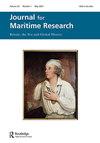‘The deadliest thing that keeps the seas’: the technology, tactics and terror of the submarine in The War Illustrated magazine
Q3 Arts and Humanities
引用次数: 2
Abstract
ABSTRACT This paper explores the representation of the submarine as an embryonic and influential factor in the First World War. In War Illustrated, reporting of German and British submarines assumed a high profile because of spectacular successes (such as U-9’s sinking of HMS Aboukir, Cressy and Hogue), and because of the perceived inactivity of the opposing battle fleets. The evolution of the magazine’s reporting of the submarine (from dismissal of its danger, to condemnation of its ‘piratical’ deployment, to celebration of its technological advancement) reflected the divisive characteristics of submarine warfare and the troubled reputation of the Royal Navy in the public imagination. The submarine’s emergence within twentieth-century warfare can be traced through the problematic popular responses to its unique capabilities and contribution to the naval campaign.在《战争画报》杂志上,“保持海洋的最致命的东西”:潜艇的技术、战术和恐怖
摘要:本文探讨了潜艇作为第一次世界大战的萌芽和影响因素的表征。在《战争画报》上,关于德国和英国潜艇的报道之所以引人注目,是因为它们取得了惊人的成功(比如U-9击沉了HMS Aboukir, cresy和Hogue),也因为人们认为对方的战斗舰队不活跃。该杂志对潜艇报道的演变(从无视其危险,到谴责其“海盗式”部署,再到庆祝其技术进步)反映了潜艇战的分裂特征和皇家海军在公众想象中的麻烦声誉。潜艇在20世纪战争中的出现可以追溯到对其独特能力和对海军战役贡献的有问题的大众反应。
本文章由计算机程序翻译,如有差异,请以英文原文为准。
求助全文
约1分钟内获得全文
求助全文
来源期刊

Journal for Maritime Research
Arts and Humanities-History
自引率
0.00%
发文量
0
期刊介绍:
The Journal for Maritime Research ( JMR ), established by the National Maritime Museum in 1999, focuses on historical enquiry at the intersections of maritime, British and global history. It champions a wide spectrum of innovative research on the maritime past. While the Journal has a particular focus on the British experience, it positions this within broad oceanic and international contexts, encouraging comparative perspectives and interdisciplinary approaches. The journal publishes research essays and reviews around 15-20 new books each year across a broad spectrum of maritime history. All research articles published in this journal undergo rigorous peer review, involving initial editor screening and independent assessment, normally by two anonymous referees.
 求助内容:
求助内容: 应助结果提醒方式:
应助结果提醒方式:


